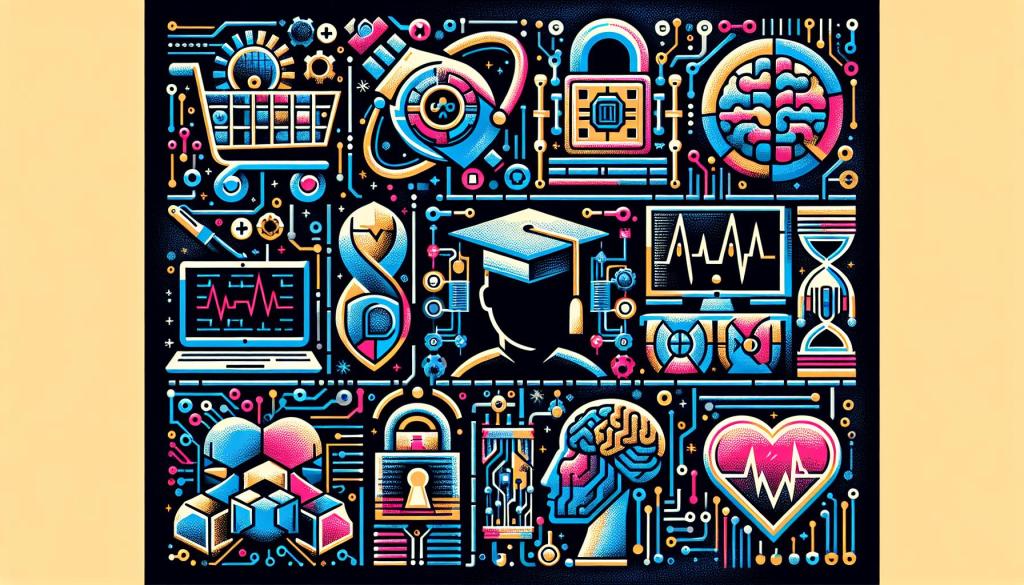Updated: Jul 24, 2024 By: Marios

In the digital age, artificial intelligence (AI) is no longer a far-off concept reserved for sci-fi novels; rather, it's a reality that's transforming our everyday lives. From voice-activated personal assistants to predictive features app in our favorite apps, AI is everywhere. But how can we harness its full potential?
In this article, I'll demystify AI and guide you through the practical ways you can integrate it into your daily routine or business strategy. Whether you're a tech novice or a seasoned pro, you'll discover how AI can streamline tasks, boost productivity, and even unlock new opportunities. So let's dive in and explore the fascinating world of AI together.
Understanding What AI is and its Relevance
Building on what we've already covered, AI, or Artificial Intelligence, refers to the simulation of human intelligence processes by machines, specifically computer systems. These processes include learning, reasoning, self-correction, perception, and language understanding. Now, let's delve deeper into AI's significant elements: Algorithms, Machine Learning, and Deep Learning.
Algorithms in AI
Forming the backbone of AI, algorithms represent a sequence of statistical processing steps. For illustration, Google uses AI algorithms to rank websites in search results, ensuring you find the most relevant content quickly.
Machine Learning: An Integral Part of AI
Another key component of AI, Machine Learning (ML) involves the scientific study of algorithms and statistical models that computer systems use to perform specific tasks. An instance: Gmail’s spam filter employs machine learning to differentiate between normal emails and unwanted ones, enhancing user experience.
Deep Learning: Taking AI a Step Further
Deep Learning, a subset of Machine Learning, features app neural networks with several layers. These complex models assist in making decisions about intricate tasks, such as image recognition or speech understanding. For example, Facebook uses deep learning for automatic tagging features app, identifying friends in photos posted on the platform.
With this information in mind, it's apparent how AI's relevance spans across different industries and daily applications. From recommendation engines like Netflix's “What to Watch Next” feature, powered by AI, to Tesla's self-driving cars that rely heavily on AI for operation, Artificial Intelligence offers significant potential benefits. As such, harnessing the power of AI becomes an essential skill in today's digitally-driven landscape.
Practical Applications of AI in Various Industries

Let's explore how artificial intelligence threads its way through various industries, revolutionizing operations and outcomes.
Leveraging AI in E-Commerce
AI transforms e-commerce, driving efficient operations and improved decision-making. Personalized marketing, a prominent application of AI, tailors individual customers' experiences. Companies like Amazon employ AI for product recommendations, boosting sales and customer satisfaction. Predictive analytics, another AI tool, helps foresee trends, enabling efficient inventory management.
Enhancing Education with AI
AI proves pivotal in enhancing the educational landscape by personalizing and streamlining educational experiences. Intelligent Tutoring Systems (ITS), AI-powered platforms, customize study materials to match individual learner's pace and level. For instance, Duolingo, a language-learning platform, employs AI to adapt its curriculum dynamically. AI also administers effective assessments and feedback, enabling timely interventions and improvement.
Utilizing AI in Healthcare
AI's transformative potential manifests in healthcare through improved diagnostics and patient care. IBM's Watson, an AI platform, exemplifies this by assisting in the accurate and quick diagnosis. AI algorithms also analyze medical records and population data to predict health risks, helping in the prevention of diseases.
AI in Data Security and Management
Learn about alternative paths to integrating technology with music creation. With technological advancements, exploring apps for different purposes becomes exciting. One can now find an app to release tracks, upload music on the go, and keep track of all necessary data swiftly.
AI enhances data security and management practices. With cybersecurity threats evolving, AI-driven security systems provide proactive solutions through risk prediction and automated responses.
Companies like Darktrace employ AI for real-time threat detection. In terms of data management, AI aids in efficient data sorting, analysis, and correlation, assisting organizations in harnessing actionable insights.
To stay ahead of threats, many organizations are now utilizing some of the best AI security tools available.
The Role of AI in Entertainment
The entertainment industry reaps AI's benefits, delivering individualized content and improved user experience. Netflix stands as an example with its AI-powered recommendation engine tailoring users' preferences. Notably, AI also drives content creation processes. For instance, AI music composition and AI-generated artwork represent emerging areas of automated creativity.
With these examples, it's easy to detect that AI's relevance is not limited to merely a single industry – its transformative impact echoes in various sectors. That's why understanding AI and acquiring skills related to it, becomes a pinnacle in today's digital era.
Utilizing AI to Simplify Everyday Tasks

Harnessing the power of AI streamlines sundry daily tasks, breathing fresh energy into familiar spaces. From the development of innovative products to parsing customer feedback, AI stretches its transformative touch to cover every corner.
Development of New Products or Features
AI proves instrumental in shaping awe-inspiring products and avant-garde features app. Machine Learning, a critical AI component highlighted previously, enables systems to learn from data, gleaning insights that fuel innovation. Take Spotify's “Discover Weekly,” for example. This feature, engineered by AI, curates personalized playlists based on listeners' tastes, creating a bespoke listening experience every time.
Analysis of Customer Feedback
AI’s magic extends to the realm of customer feedback as well. Sentiment analysis, an AI offshoot, processes vast volumes of customer reviews, identifying patterns and gleaning actionable insights. Airbnb, known for hosting millions of listings worldwide, leverages this AI aspect to harness critical feedback and upgrade services, thereby refining the user experience.
Assisting with SEO
Swimming in the sea of Search Engine Optimization? AI serves as an indispensable lifesaver. AI-driven tools such as RankBrain play a significant role in understanding and processing search queries, thereby optimizing search engine results. Google, the search giant, relies heavily on AI to maintain its precision in delivering appropriate, user-friendly search outcomes.
Creating Attention-Grabbing Social Media Posts
Social media, the world's entertainment hotbed, bears witness to AI's compelling influence. AI tools like Lumen5 transform dull, static blog content into dynamic, crisp social media videos, capturing audiences' attention and piquing their interest. These AI-enabled posts are the new rage, drenching platforms like Instagram and Facebook in vibrant hues of buzzworthy content.
Just as mentioned earlier, the relevance of AI spreads across all facets of digital existence. Understanding AI's multifaceted advantages offers a competitive edge, paves the way for a technology-oriented future, and simplifies handling mundane everyday tasks.
Ways to Use AI in Content Creation and Productivity

Augmenting content creation and productivity with artificial intelligence (AI), steers you towards a futuristic arena, a technologically advanced work environment. Let's explore in-depth how AI contributes.
AI for Text and Content Creation
AI modifies my approach to writing and text creation by enabling me to generate ideas, enhance the readability of text, and simplify editing. Tools like OpenAI's GPT-3 can produce human-like text, leading to more engaging and diversified content. Plural nouns such as “grammar checks” and “content optimizers” reference AI advantages. For example, software like Grammarly performs real-time grammar checks, thus fine-tuning the content.
Utilizing AI for Graphic Design and Art
In the realm of graphic design and art, AI-informed tools act as my allies. Myriad solutions, such as Deep Art Effects and PaintsChainer, help me turn photographs into art, create custom design elements, and enhance photo quality. Programmes like Canva use AI for suggestion of design templates based on content input. Automated design reduces dependency on specific skills, bridging the gap between ideas and realization effectively.
Audio Productivity and Production with AI
Channeling AI to boost audio productivity and production has streamlined my audio processing tasks. AI-driven tools such as Descript and Audacity fascinate me by translating audio files to text, performing automatic audio editing, and even creating original, tailored soundtracks. Referencing podcast creators, audio files transcribe seamlessly into text, saving hours, and improving workflow efficiency. Thus, AI-based tools are vital assistants, increasing precision and productivity in the audio production process.
Challenges and Solutions in Implementing AI
Though AI presents a myriad of benefits as laid out in previous sections, it's not without its challenges. These comprise trust and transparency issues, unintended bias, and the potential for overuse and overreach. Unraveling these concerns can allow an optimized and more beneficial use of AI.
Navigating Data Trust and Transparency Issues
Data transparency and trust represent a significant challenge in AI. It's because users often lack insight into how AI makes decisions or processes data. The solution lies in creating ‘explainable AI', where the AI system explains its methodology and reasoning to users. For instance, PwC's XAI (Explainable AI) provides insights into AI models to help increase user trust and transparency.
Addressing Biased Input and Output
Bias in AI stems from biased input data, leading to skewed or prejudiced outcomes. To combat this, mandating diversity in AI training datasets becomes crucial. IBM's AI Fairness 360, for example, serves as a comprehensive toolkit that aids in detecting and mitigating bias in AI development stages.
Avoiding Overuse and Overreach of AI
With AI's advantages, it's easy to fall into the trap of overuse and overreach, potentially leading to dependence and loss of human skills. The key lies in balancing AI automation with human interaction. Companies like Google promote this through phased AI integration, mitigating the risk of AI overdependence, and retaining the need for human capabilities.
Best Practices for Incorporating AI

Incorporating AI poses unique challenges. It enhances efficiency but requires strategic implementation. This section reviews best practices for AI adoption, focusing on building an effective internal governance team, conducting rigorous AI reviews, and establishing clear usage guidelines.
Building an Internal Governance Team for AI
Creating a robust internal team can steer AI's effective governance. AI's integration isn't merely a technology project. It's an expansive endeavor spanning departments. It's advisable for organizations to form a multidisciplinary AI governance team. They leverage a broader perspective, factoring in ethical, legal, and societal dimensions arising from AI. For instance, Google's Advanced Technology External Advisory Council (ATEAC) consisted of experts from diverse fields to manage ethical concerns surrounding AI and machine learning.
Conducting Thorough AI Reviews
A meticulous AI review is crucial to its success. This involves inspecting the design, learning mechanisms, data sets, and functionality of AI systems. A robust review process scrutinizes AI algorithms for bias, transparency, and legal compliance, among other factors. For example, IBM's AI Fairness 360 toolkit evaluates, mitigates and monitors unintended bias in AI and machine learning models.
Setting Clear Guidelines for AI Use
Clear guidelines for AI usage maximize benefits while avoiding pitfalls. Guidelines touch upon many aspects, right from data collection to decision-making processes. Policies can determine the type of data AI systems can collect, process, or store. They can also regulate how AI contributes to decision-making within organizations. For instance, Salesforce rolled out an AI Ethical Use Guide, delineating its commitment to accountability, transparency, and fairness in AI use.
The Future of AI: Trends and Predictions
Predicted trends indicate an amplified role for AI in multiple walks of life. For example, Google's AI-powered predictive applications, IBM's machine learning techniques, and Salesforce's automated systems represent mere glimpses of what's in store.
Revolutionizing Data Interpretation
AI revolutionizes data interpretation, enabling elaborative predictive modeling. Current implementations, like in e-commerce where predictions about consumer behavior improve sales, touch upon the possibilities of future advancements. For instance, healthcare may improve patient outcomes through advanced predictive analytics, driven by sophisticated AI systems.
Enriching Interactive Technologies
The infusion of AI in interactive technologies is another trend. Chatbots used by businesses to enhance customer experience embody they way AI makes technology more accessible. As improvements continue, we may see an increased reliance on AI in interfaces, creating more intuitive and personalized user experiences.
AI and Cybersecurity
There's a clear prediction for AI to play a prominent role in cybersecurity. Currently, AI helps detect and neutralize threats. As intrusions become more complex, the role of AI will expand, potentially involving preventive strategies based on predictive analysis.
Incorporating AI in Edge Computing
Edge computing, leveraging AI, could transform data processing. Usage of edge devices like surveillance cameras and Internet of Things (IoT) gadgets could be optimized with AI, enhancing real-time data analysis and decision-making processes.
Regulatory Policies for AI
Finally, regulatory policies around AI will likely tighten. As AI penetrates various sectors like banking and healthcare, the need for comprehensive regulations becomes evident. These policies should balance stimulating innovation while ensuring ethical AI use.
Keep in mind that the outlined trends are projections, based on present data and observations. The actual future of AI is subject to developments across science, technology, and society at large. There's an element of uncertainty that makes these predictions exciting yet challenging to realize accurately. Be prepared, the future of AI holds promising, innovative potential.
Conclusion
As we've journeyed through the expansive world of AI, it's clear that its influence is profound and ever-growing. From everyday tasks to complex business operations, AI is reshaping our world. It's not just about algorithms or machine learning, but about harnessing these elements to create solutions that are transformative and beneficial. Overcoming challenges and optimizing AI's potential is a journey, not a destination.
As we look ahead, trends like predictive applications, data interpretation, and cybersecurity underscore AI's dynamic future. Yet, it's important to remember that as AI's reach extends, so does the need for robust regulatory policies. The future of AI is promising and packed with potential, but it's also a path we tread carefully, understanding its implications and embracing its possibilities.
Frequently Asked Questions
What role does AI play in our daily lives?
AI has an extensive influence in our society, facilitating intricate tasks from personal assistance through Siri or Alexa, to complex operations such as fraud detection in banking and optimizing business operations across various sectors.
What is artificial intelligence and how does it work?
AI involves the creation and use of machines that simulate human intelligence. They can understand languages, recognize patterns, and solve problems by integrating components like algorithms, machine learning, and deep learning.
How is AI used in various industry sectors?
Vital sectors like e-commerce, education, healthcare, and data security have successfully integrated AI to optimize productivity, efficiency and data interpretation. It's used in personalizing content, route recommendations in navigation apps, and more.
What are the challenges of implementing AI?
The primary challenges for AI implementation include the need for valid and reliable data, complexity of predictive models, and the need for robust hardware. However, these can be mitigated with relevant optimization solutions.
What are the regulatory policies around AI?
As AI continues to impact various industries, tight regulatory policies are emerging to govern its use and implementation, ensuring that it is used ethically and responsibly.
How can we prepare for future AI trends?
Understanding the current trends and predictions in AI, such as its increasing role in predictive applications, data interpretation, interactive technologies, and cybersecurity, can help individuals and organizations prepare for its future impact and benefits.



